
A slave rebellion is an armed uprising by slaves, as a way of fighting for their freedom. Rebellions of slaves have occurred in nearly all societies that practice slavery or have practiced slavery in the past. A desire for freedom and the dream of successful rebellion is often the greatest object of song, art, and culture amongst the enslaved population. These events, however, are often violently opposed and suppressed by slaveholders.

Slavery in the colonial history of the United States refers to the institution of slavery as it existed in the European colonies which eventually became part of the United States. In these colonies, slavery developed due to a combination of factors, primarily the labour demands for establishing and maintaining European colonies, which had resulted in the Atlantic slave trade. Slavery existed in every European colony in the Americas during the early modern period, and both Africans and indigenous peoples were victims of enslavement by European colonizers during the era.
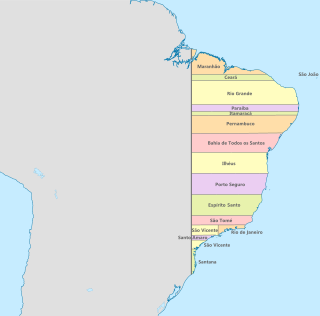
Colonial Brazil comprises the period from 1500, with the arrival of the Portuguese, until 1815, when Brazil was elevated to a kingdom in union with Portugal as the United Kingdom of Portugal, Brazil and the Algarves. During the early 300 years of Brazilian colonial history, the economic exploitation of the territory was based first on brazilwood extraction, which gave the territory its name; sugar production ; and finally on gold and diamond mining. Slaves, especially those brought from Africa, provided most of the work force of the Brazilian export economy after a brief period of Indian slavery to cut brazilwood.

A quilombo is a Brazilian hinterland settlement founded by people of African origin, and others sometimes called Carabali. Most of the inhabitants of quilombos, called quilombolas, were maroons, a term for escaped slaves.
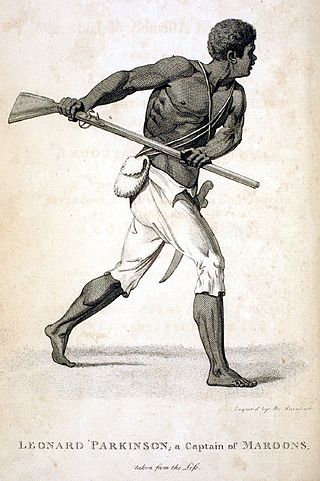
Maroons are descendants of Africans in the Americas and Islands of the Indian Ocean who escaped from slavery and formed their own settlements. They often mixed with indigenous peoples, eventually evolving into separate creole cultures such as the Garifuna and the Mascogos.

Slavery in the Spanish American colonies was an economic and social institution which existed throughout the Spanish Empire including Spain itself. Indigenous peoples were enslaved and their populations decimated. Subsequently enslaved Africans were brought over. Native people were also subjected to forced conversions and conscription.
Bayano, also known as Ballano or Vaino, was an African enslaved by Portuguese who led the biggest slave revolts of the 16th century Panama. Captured from the Yoruba community in West Africa, it has been argued that his name means idol. Different tales tell of their revolt in 1552 beginning either on the ship en route, or after landing in Panama's Darien province along its modern-day border with Colombia. Rebel slaves, known as cimarrones, set up autonomous regions known as palenques, many of which successfully fended off Spanish control for centuries using guerrilla war and alliances with pirates, or indigenous nations who were in similar circumstances.
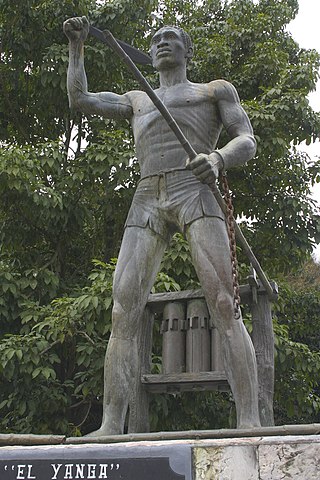
Gaspar Yanga — often simply Yanga or Nyanga was an African who led a maroon colony of enslaved Africans in the highlands near Veracruz, Mexico during the early period of Spanish colonial rule. He successfully resisted a Spanish attack on the colony in 1609. The maroons continued their raids on Spanish settlements. Finally in 1618, Yanga achieved an agreement with the colonial government for self-rule of the maroon settlement. It was later called San Lorenzo de los Negros, and also San Lorenzo de Cerralvo.

San Basilio de Palenque or Palenque de San Basilio, often referred to by the locals simply as Palenke, is a Palenque village and corregimiento in the Municipality of Mahates, Bolivar in northern Colombia. Palenque was the first free African town in the Americas, and in 2005 was declared a Masterpiece of the Oral and Intangible Heritage of Humanity by UNESCO.
A freedman or freedwoman is a formerly enslaved person who has been released from slavery, usually by legal means. Historically, slaves were freed by manumission, emancipation, or self-purchase. A fugitive slave is a person who escaped enslavement by fleeing.
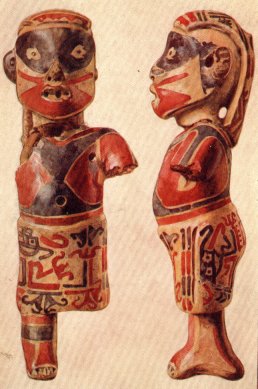
In the history of Panama, the earliest known inhabitants were the Cueva and Coclé tribes, but they were drastically reduced by disease and fighting when the Spanish arrived in the 16th century. But some moved out of Panama to have children and increase population.

Afro-Panamanians are Panamanians of African descent. The Afro-Panamanian population can be mainly broken into one of two categories "Afro-Colonials", Afro-Panamanians descended from slaves brought to Panama during the colonial period, and "Afro-Antilleans," West Indian immigrant-descendants with origins in Trinidad, Martinique, Saint Lucia, Guadeloupe, Dominica, Grenada, Haiti, Belize, Barbados, and Jamaica, whose ancestors were brought in to build the Panama Canal. Afro-Panamanians can be found in the towns and cities of Colón, Cristóbal and Balboa, the Río Abajo area of Panama City, the Canal Zone and the province of Bocas del Toro.

Slavery among Native Americans in the United States includes slavery by and enslavement of Native Americans roughly within what is currently the United States of America.
The Cimarrons in Panama were enslaved Africans who had escaped from their Spanish masters and lived together as maroons. In the 1570s, they allied with Francis Drake of England to defeat the Spanish conquest. In Sir Francis Drake Revived (1572), Drake describes the Cimarrons as "a black people which about eighty years past fled from the Spaniards their masters, by reason of their cruelty, and are since grown to a nation, under two kings of their own. The one inhabiteth to the west, the other to the east of the way from Nombre de Dios".
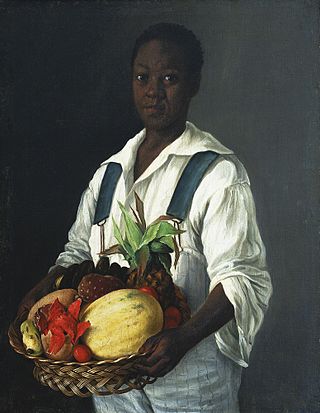
Afro-Mexicans, also known as Black Mexicans, are Mexicans who have heritage from sub-Saharan Africa and identify as such. As a single population, Afro-Mexicans include individuals descended from both free and enslaved Africans who arrived to Mexico during the colonial era, as well as post-independence migrants. This population includes Afro-descended people from neighboring English, French, and Spanish-speaking countries of the Caribbean and Central America, descendants of enslaved Africans in Mexico and those from the Deep South during Slavery in the United States, and to a lesser extent recent migrants directly from Africa. Today, there are localized communities in Mexico with significant although not predominant African ancestry. These are mostly concentrated in specific communities, including the populations of the Oaxaca, Huetamo, Lázaro Cárdenas, Guerrero, and Veracruz states.

Afro-Nicaraguans are Nicaraguans of Sub-Saharan African descent. Five main distinct ethnic groups exist: The Creoles who descend from Anglo-Caribbean countries and many of whom still speak Nicaragua English Creole, the Miskito Sambus descendants of Spanish slaves and indigenous Central Americans who still speak Miskito and/or Miskito Coast Creole, the Garifunas descendants of Zambos expelled from St. Vincent who speak Garifuna, the Rama Cay zambos a subset of the Miskito who speak Rama Cay Creole, and the descendants of those enslaved by the Spanish.
Miguel I of Buría, also known as King Miguel, Miguel the Black and Miguel Guacamaya, was formerly enslaved in San Juan, Puerto Rico, and reigned as the King of Buría in the modern-day state of Lara, Venezuela. His incumbency began in 1552 and lasted until some point between 1553 and 1555.

Slavery was practiced in Colombia from the beginning of the 16th century until its definitive abolition in 1851. This process consisted of trafficking in people of African and indigenous origin, first by the European colonizers from Spain and later by the commercial elites of the Republic of New Granada, the country that contained what is present-day Colombia.
The largest slave traders in Mexican territory were the Portuguese and the English. The countries that controlled the transatlantic slave market in terms of number of slaves shipped were Great Britain, France, and Portugal.











